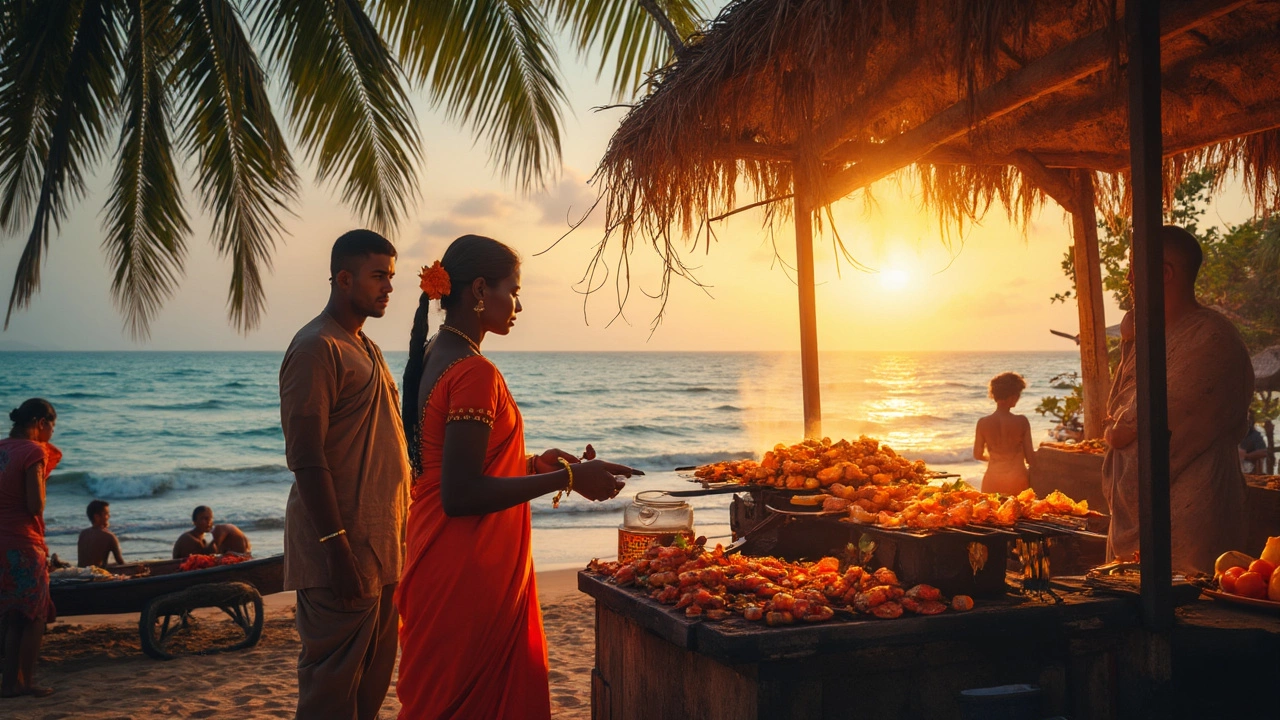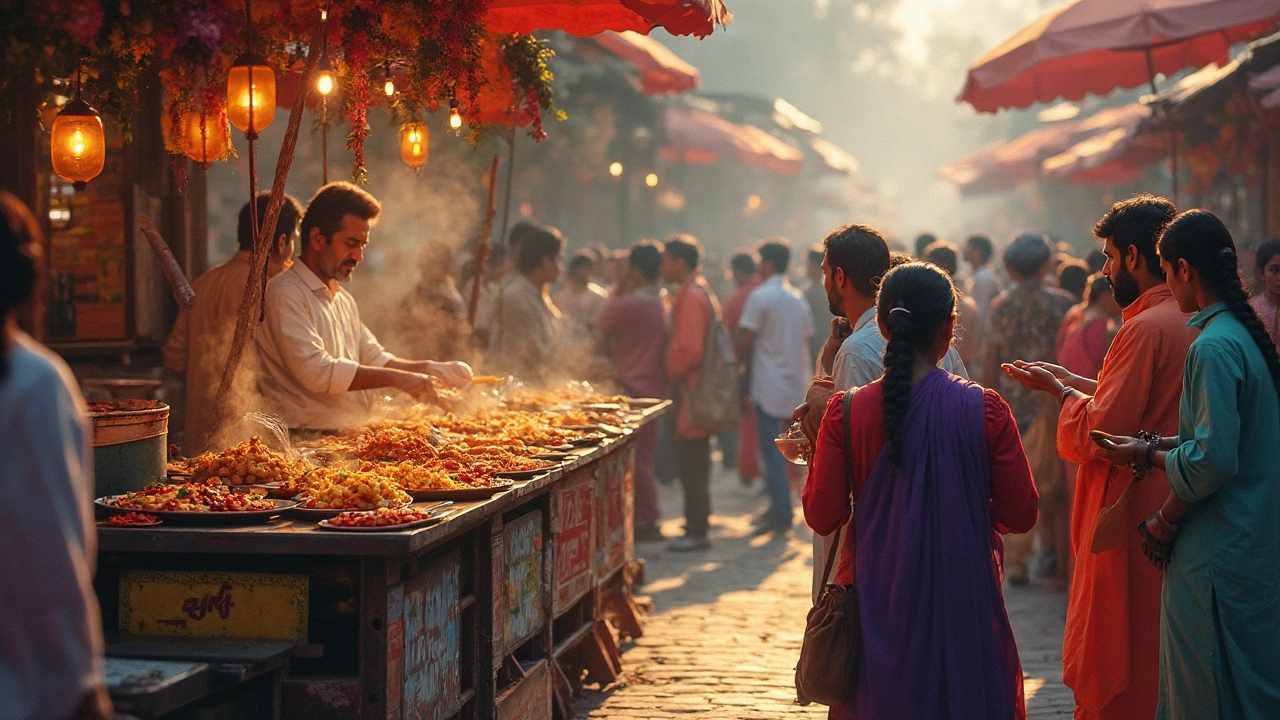India's street food scene isn't just about grabbing a quick bite; it's a whole experience that tickles your taste buds and gives you a taste of the country's diverse culture. From spicy to sweet, every stall and cart seems to be a gateway to India's rich culinary traditions. The streets buzz with vendors frying, grilling, and tossing ingredients to whip up something irresistible.
If you're roaming through Delhi's chaotic streets or lounging on a beach in Goa, chances are you'll bump into a food vendor selling something mouthwatering. But it’s not just about the food itself—it's about the stories and history wrapped up in each dish. From Pani Puri to Dosa, each street food item has its unique flavor and background.
Whether you're a first-timer or a seasoned street food pro, it's always good to approach with a bit of knowledge about what's on offer and how best to enjoy it without your stomach grumbling in protest later. Knowing a few go-to dishes and how to spot a clean eatery can turn your street food adventure from risky to really rewarding.
- The Charm of Indian Street Food
- Regional Varieties
- Must-Try Delights
- Hygiene and Safety
- Eating Etiquette
- Ordering Like a Local
The Charm of Indian Street Food
There's something uniquely thrilling about indulging in Indian street food. It's like unraveling a tapestry of flavors where every bite tells a story of tradition, culture, and innovation. It’s not just about eating; it’s about experiencing a slice of life in India.
Street food in India serves as a great equalizer. Whether you’re a local or a tourist, everyone flocks to the streets for a taste of local favorites. It’s not uncommon to find people from all walks of life lining up for the same juicy samosas or spicy chaat. This shared experience is where the magic really happens.
The diverse influence on Indian street food comes from its myriad regions. For example, you'll encounter the savory bhajiyas of Mumbai or the crispy jalebis hanging around Jaipur's corners. Each region brings its unique touch, making every trip to a street vendor an adventure.
Moreover, the affordability of these culinary delights makes them accessible to everyone. You can enjoy a hearty meal without breaking the bank, which means you get more bang for your buck as opposed to eating at a fancy restaurant.
And let's not forget the sheer ingenuity of these street vendors. They whip up dishes with such speed and precision, it’s like watching a live cooking show. They create unforgettable explosions of flavors using just a simple cart and basic ingredients.
This is the magic of Indian street food: a blend of affordability, diversity, and communal enjoyment that makes it a truly local—and utterly delicious—experience.
Regional Varieties
India's street food is as diverse as its culture, with every region boasting its unique flavors and combinations. The beauty of Indian street food lies in its regional twists, turning simple ingredients into unforgettable delights.
Head up north to Delhi, and you're in samosa heaven. These crispy, spicy potato-filled snacks are a staple here, perfect for munching on the go. But that's not all, Delhi's chole bhature, a combination of spicy chickpeas and fluffy bread, will fill you up in the most satisfying way.
Venture to Mumbai, and the bustling city life reflects in its street food. Vada pav is a must—imagine a spicy potato dumpling sandwiched in a soft bun. It's like the Indian version of a burger but with a punch! And if you're in Kerala, keep an eye out for banana chips. They’re not your typical chips—these are fried to perfection and have a slight sweetness that hits the spot.
Over in Kolkata, the iconic kathi roll steals the show. It's basically a flatbread rolled with spicy fillings, ranging from egg to chicken, depending on your mood. Meanwhile, in Gujarat, the streets are filled with the aroma of dhokla—a savory, steamed cake that’s both fluffy and tangy.
Eating habits in India are heavily influenced by these regional specialties, and understanding them adds so much to the experience. Every corner you turn introduces you to something new and delicious. When in these regions, trust the locals to point you towards the top spots to try.
Must-Try Delights
Dive into the world of Indian street food, and you'll quickly find an overwhelming number of options. Some of these delights are simply iconic, and you really shouldn't leave India without trying them.
First up, there's Pani Puri, known as Golgappa in North India and Phuchka in Bengal. Imagine small, crispy puris filled with spicy tangy water, potatoes, and sometimes chickpeas. Eating them can be a fun challenge, as they're typically enjoyed whole. The burst of flavors with each bite is what makes them so addictive.
Then you've got Vada Pav, a hugely popular snack from Mumbai. It's essentially a spicy potato fritter tucked inside a bun, served with garlic chutney and fried green chilies. Think of it as India's answer to the burger, but with a spicy twist.
In the south, you can't miss Dosa. This is a type of crepe made from fermented rice batter, often served with coconut chutney and sambar, a savory lentil stew. The crispy texture of a well-cooked dosa paired with the spicy and tangy accompaniments is pure bliss.
Looking for something sweet? Try Jalebi, deep-fried batter soaked in sugar syrup. It's spiraled perfection, crispy-yet-syrupy, and utterly satisfying. Pair it with Rabri, a thickened, sweetened milk concoction, and you've got a dessert to remember.
For those who love a bit of skewered goodness, Seekh Kebabs are a must. Minced meat seasoned and grilled on skewers till it's succulent and smoky. Often served with mint chutney, these can be found sizzling away on street-side grills.
Remember, while exploring these treats, keep an open mind and a hearty appetite. The food culture in India is diverse, and each dish tells its own story. Enjoy the experience, and maybe even learn a few local words to enhance your ordering game!

Hygiene and Safety
Okay, so you're super excited about digging into some street food in India, but let's keep it real—it's crucial to think about hygiene and safety. Nobody wants to deal with a stomach upset while on foodie adventures!
First things first, choose vendors who are busy. A long line is usually a good sign that the turnover is quick, which means the food is fresh, and it hasn't been sitting around. Also, check out how the vendor handles food. Basic stuff, like using tongs or wearing gloves, can make a big difference.
"In bustling street markets, opting for popular spots often ensures quality and safety," says Priya Kapoor, a food writer for 'Taste of India.'
Try to avoid chilled foods like some dairy products unless they’re from a reputable place. The hot items are generally a safer bet since high cooking temperatures kill off most germs. Plus, it's wise to stick to bottled water or fresh drinks that are being made right in front of you. Showing off your skills by eating tap water ice cubes might not be the highlight of your trip.
If you're wondering which adventures are worth the risk, here's a simple tip: go for what sizzles. Fried foods like samosas tend to be safer and enjoyably spice-filled.
- Pick busy stalls. More turnover means fresher food.
- Look for vendors who use gloves or utensils.
- Eat items served hot to keep those germs away.
- Opt for bottled drinks or freshly made juices.
So, feel free to wander the vibrant streets and let the aroma guide your tastebuds, but just keep these hygiene tips in your back pocket! Enjoy your Indian street food journey, safely!
Eating Etiquette
Diving into Indian street food is a thrill, but knowing a bit about eating etiquette can help you feel more comfortable and make the experience even better. Many of these customs stem from deep cultural traditions, so having a heads-up is always handy.
An essential tip is to use your right hand when eating. In India, the left hand is traditionally considered unclean, so whether you're grabbing a samosa or dipping into a spicy curry, stick to your right. It's a small gesture that shows respect for local customs.
Another interesting aspect is the sharing culture. Street food is often enjoyed best with friends and family. Grabbing a few dishes to share among the group fosters a sense of community and makes trying multiple dishes easier and more fun.
When it comes to paying, exact change is greatly appreciated by street vendors. It helps the transaction go smoothly and saves everyone time. Also, polite interactions go a long way. A smile and a simple 'thank you' in Hindi, 'Dhanyavaad,' can warm up even the busiest vendor.
As renowned chef and restaurateur Sanjeev Kapoor says, "Street food in India is a rush of emotions, and understanding how to navigate it is essential to truly enjoy the culinary journey."
If you're worried about communication, fear not! Many vendors understand basic English or gestures, so pointing and smiling can get you far. Still, learning key phrases like 'how much?' or 'very tasty'—'kitna?' and 'bahut swadisht' respectively—can enhance your experience.
Being mindful of the line at popular stalls also helps. Waiting your turn patiently is always appreciated. And hey, good things come to those who wait, right?
So, remember this handful of pointers when you're diving into the world of eating habits in India. They'll help you enjoy the flavorful chaos with ease and show you're a respectful and eager eater.
Ordering Like a Local
Getting your hands on authentic Indian street food is already an adventure, but knowing how to order like a pro takes it up a notch. Imagine walking up to a busy vendor and feeling completely at ease—yeah, that's the goal!
First, don’t be shy about asking questions. Vendors usually offer a variety of items, and they’re often happy to explain what everything is, especially if you seem genuinely interested in their craft. Spotting a crowd around a stall is usually a reliable sign of tasty fare, so don’t hesitate to join in.
For those looking to fit in with the locals, try your hand at ordering in the local language if you can. A simple "Ek plate chaat," which means "one plate of chaat," can earn you a friendly smile and maybe even a little extra chutney on your dish.
Here's a quick guide to make your ordering smoother:
- Watch first: Observe a couple of orders before diving in. This will give you an idea about the food being served and how others order.
- Go specific: If you know what you want, be specific. Saying "Aloo tikki without chutney" helps them get your order right, especially if you’re wary of spicy food.
- Ask for popular: If in doubt, ask what's popular or recommended. Vendors love to show off their specialties.
- Mind your change: Have small change handy. It speeds up the transaction and is appreciated by vendors who deal with lots of customers.
Asking about the eating habits in India can also be a great conversation starter. Street food is closely tied to local daily life, and often, the person making your food can tell you a story or two about the dish's origin or why it's special in that particular region.
Finally, enjoy your food like a local—stand alongside others, savor each bite, and don’t rush. Indian street food is as much about the social experience as it is about the flavors on your plate.
